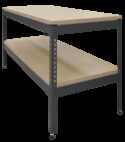Experiment
SM1006

CREEP TESTING MACHINE
A bench-mounted machine that demonstrates the phenomenon of creep under different conditions and in different materials.
If you have any questions or you'd like to discuss a product, please call us.
+44 1159 722 611CREEP TESTING MACHINE
This simple machine uses specimens of lead and different plastics which creep significantly at room temperature and under low loads.
Its main part is a simple lever (load beam) with a mechanical advantage of 8:1. The load beam gives a steady and uniform tensile load. A digital indicator measures the extension (creep) of the specimen under load. To ensure correct loading of the specimen, the load beam has a ball-bearing pivot.
To apply a load, students add weights to a weight hanger and measure time and the creep. For effect-of-temperature tests, the student freezes or heats a cool-pack and places it next to the specimen. They then fit the transparent enclosure to preserve the temperature around the specimen during the test.
Students may record and plot results by hand, using a timer (not supplied) and the readings from the digital indicator and thermometer. Alternatively, the student can use TecQuipment’s optional Versatile Data Acquisition System (VDAS®) to capture the data, plot charts and export data.
A user guide is supplied with the Creep Machine. The guide includes full details of the equipment, detailed experiment procedures, theory and results.
For quick and reliable tests, TecQuipment can supply VDAS® which gives accurate real-time data capture, monitoring and display, calculation and charting of all important readings on a computer.
For connection to VDAS® the Creep Machine includes a thermocouple with in-line transmitter, and a lead to connect the digital indicator to VDAS®.
Learning outcomes
- The normal breaking load of a specimen over a fixed time
- Relationship between breaking load and time for lead specimens
- Time extension curves to show the three phases of creep (primary, secondary and tertiary)
- The effect of temperature on the creep rate of specimens
- Creep recovery

















